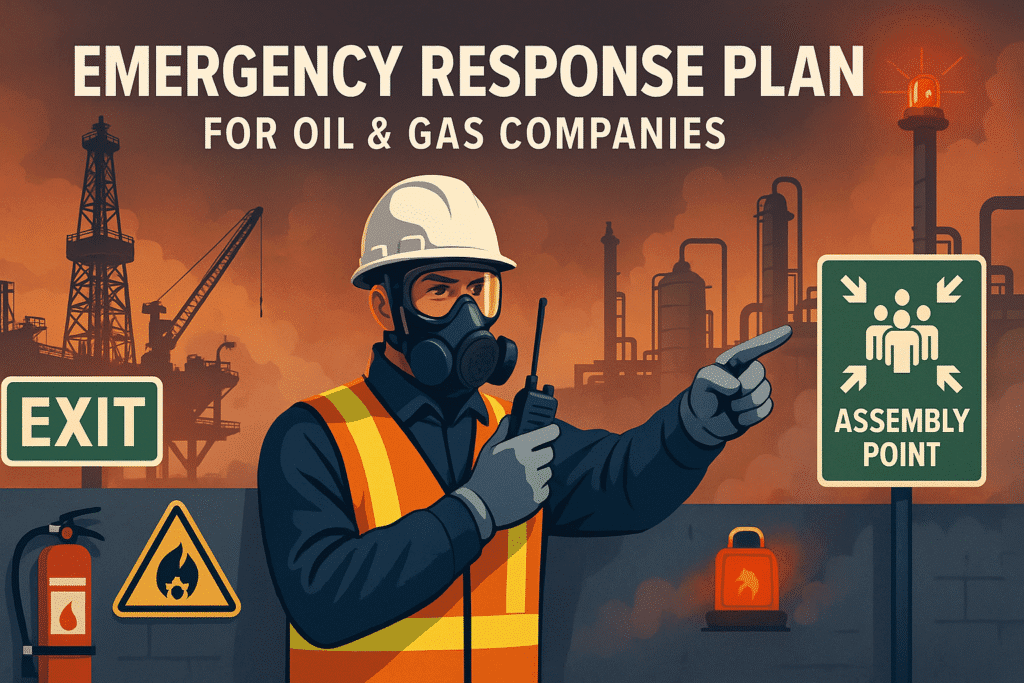
Emergency Response Plan for an Oil and Gas Company
The oil and gas industry is one of the most hazardous sectors in the world. When a gas leak or fire breaks out, response time is everything. That’s why an Emergency Response Plan (ERP) is not a luxury—it’s a necessity. In this article, we’ll break down the essential elements of an ERP tailored specifically for oil and gas operations, from upstream rigs to downstream refineries.
What is an Emergency Response Plan (ERP)?
An ERP is a structured, pre-planned protocol designed to protect lives, the environment, and assets during emergencies. It includes detailed actions, communication chains, and rescue procedures to ensure a quick and coordinated response.
Why ERP is Vital in the Oil and Gas Industry
Unlike most industries, oil and gas operations involve flammable substances, high-pressure systems, and remote locations. A small mistake can lead to:
- Loss of life
- Massive environmental damage
- Billions in financial loss
- Permanent brand damage
A proactive ERP ensures:
- Immediate control of hazards
- Efficient evacuation and rescue
- Compliance with laws and industry standards
Common Emergencies in Oil and Gas Operations
Fire and Explosion
Highly flammable gases, oils, and vapors pose constant fire risks.
Gas Leak
Leaks of methane, hydrogen sulfide, or LPG can cause asphyxiation or ignition.
Blowout or Well Control Failure
In offshore drilling, uncontrolled release of hydrocarbons can lead to catastrophic explosions.
Chemical Spill
Toxic chemicals used in processes can cause contamination or injury.
Equipment Failure
Valve malfunction, pipeline rupture, or electrical faults can quickly escalate.
Natural Disasters
Floods, hurricanes, and earthquakes disrupt operations and safety systems.
Key Objectives of an ERP in Oil and Gas
- Preserve Life: Ensure all employees and contractors are protected.
- Control Hazards: Contain or neutralize dangerous conditions.
- Minimize Environmental Damage: Prevent leaks, contamination, or spills.
- Restore Operations: Return to normal functioning swiftly and safely.
- Document and Comply: Ensure legal documentation and investigations are covered.
Risk Assessment and Hazard Identification
Every ERP begins with:
- HAZOP (Hazard and Operability Study)
- HIRA (Hazard Identification and Risk Assessment)
- QRA (Quantitative Risk Assessment)
This helps prioritize high-risk areas such as gas compression zones or flaring systems.
Emergency Response Team Structure
A predefined team structure ensures accountability. Typical team includes:
- Incident Commander
- Operations Leader
- Safety Officer
- Medical Coordinator
- Communications Lead
- Evacuation Marshal
Roles and Responsibilities
Each team member must know:
- What to do
- When to act
- How to communicate
Clear job descriptions and training are essential for execution.
Communication and Alert Systems
Time is everything. Include:
- Alarm systems with visual and audio indicators
- SCADA-based real-time alerts
- Satellite phones and handheld radios for remote areas
- Chain-of-command contact charts
Evacuation and Shelter-in-Place Procedures
You may need to evacuate or isolate depending on the emergency:
- Map out evacuation routes for each zone
- Identify muster/assembly points
- Use gas-proof shelters for shelter-in-place
- Conduct headcounts via RFID or biometric systems
First Aid and Medical Assistance
Onsite clinics should have:
- ATLS-trained medics
- Trauma kits
- Stretchers, oxygen cylinders, AEDs
- Emergency airlift arrangement with local hospitals
Firefighting and Gas Suppression Systems
Install:
- Fixed firefighting systems (CO2, foam, or deluge systems)
- Portable extinguishers for different types (ABC, D)
- Gas detection alarms and auto shut-off valves
Rescue and Recovery Operations
Rescue teams should be:
- Trained in confined space and high-angle rescue
- Equipped with breathing apparatus, lifelines, tripods
- Regularly drilled in various emergency scenarios
Training, Drills, and Simulations
- Conduct full-scale mock drills every quarter
- Include third-party observers for validation
- Evaluate time taken to respond and evacuate
- Use VR-based simulations for offshore and refinery hazards
Post-Incident Review and Corrective Action
After every emergency:
- Perform an RCA (Root Cause Analysis)
- Update ERP based on findings
- Implement lessons learned and share with staff
Integration with Local Authorities and Agencies
Coordinate with:
- Civil defense
- Local fire brigades
- Environmental protection agencies
- Coast guard (for offshore rigs)
Create MOUs for joint response efforts and drill participation.
Regulatory Compliance (OSHA, API, ISO, etc.)
Ensure your ERP aligns with:
- OSHA Process Safety Management (PSM)
- API RP 75 for offshore safety
- ISO 45001 for occupational health and safety
- Local government and environmental laws
Common Mistakes to Avoid
- Outdated emergency contact information
- Lack of regular drills
- Untrained subcontractors
- No integration with local responders
- Ignoring feedback from incident reviews
Benefits of a Robust ERP
- Saves lives
- Reduces downtime and damage
- Minimizes legal risk
- Protects the environment
- Increases stakeholder confidence
Conclusion
Emergencies in oil and gas are not if—they’re when. The right Emergency Response Plan is your shield against disaster. It empowers your team to act fast, stay safe, and reduce damage when every second counts. Train often, review regularly, and never get complacent. Safety is not a box to tick—it’s a culture to live.
Emergency Response Plan for a Construction Company
Safety Induction Training for Employees
130+ Safety Talks and Toolbox Talk Meeting Topics
4 Steps of Job Safety Analysis (JSA)
Risk Management 101: Conducting Effective Risk Assessments
Frequently Asked Questions (FAQs)
Q1: How often should ERP drills be conducted in oil & gas facilities?
Ideally every 3–6 months, including both tabletop and full-scale simulations.
Q2: What is the role of SCADA in emergency response?
SCADA provides real-time monitoring and control, triggering alerts during anomalies like gas leaks or equipment failure.
Q3: Who approves the ERP in an oil and gas company?
The HSE Manager prepares it, and it’s typically approved by senior management and audited by regulatory authorities.
Q4: What is the difference between an ERP and a Disaster Recovery Plan (DRP)?
ERP focuses on immediate life-saving actions. DRP deals with restoring operations after the emergency is controlled.